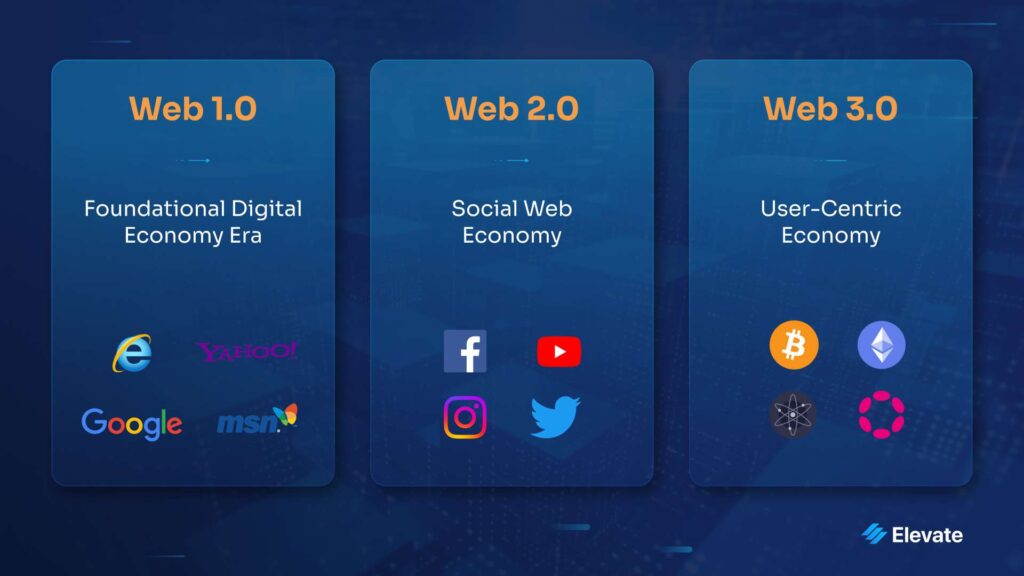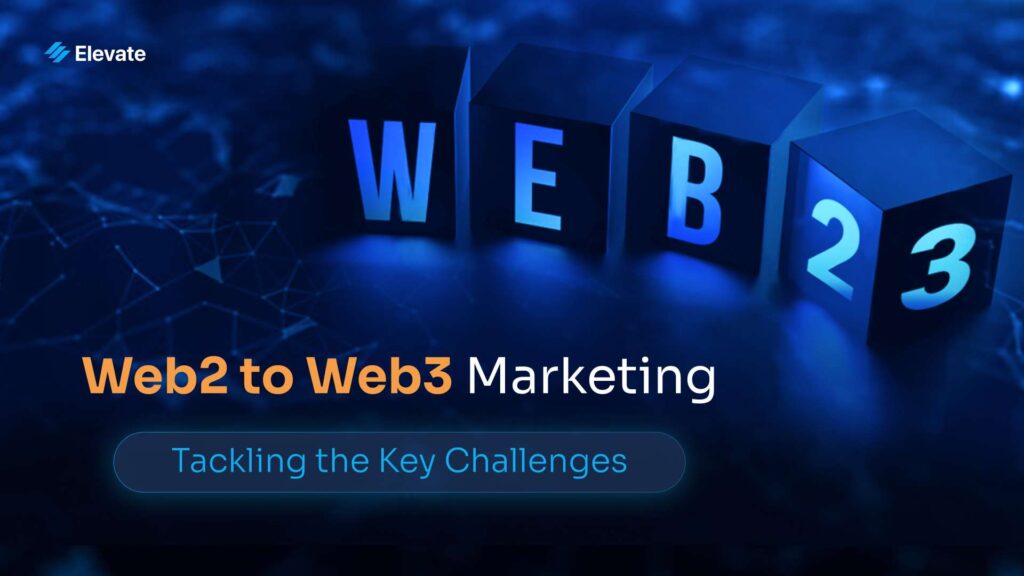The transition from Web2 to Web3 represents an important milestone in the era of digital technology, altering the foundations of how we perceive and engage with the online world. Web3, with its decentralized architecture and blockchain underpinnings, has ushered in a new era of trust, transparency, and user empowerment.
As Web3 technology gains prominence, marketing goes through fundamental changes. Traditional marketing paradigms forged in the evolution of Web2 are no longer sufficient to navigate the complexities of the decentralized Web3 landscape. The need for a strategic shift becomes apparent as marketers grapple with the challenges posed by blockchain, smart contracts, and the decentralization of data.
In this article, we delve into the key challenges accompanying the Web2 to Web3 transition and explore how the progressing framework of marketing becomes not just a necessity but a catalyst for success in the decentralized digital landscape. Join us on a journey to unravel the complexities of this transformative shift and understand why embracing Web3 is not just a technological evolution but a revolution in the way we approach marketing in the digital age.

The Essence of Web2 Marketing
Web2 marketing, based on the principles of the second generation of the internet, is characterized by centralization, controlled dissemination of information, and target audience segmentation. The core values of Web2 marketing are often centered on brand control, where businesses wield significant influence over their image and messaging. These values prioritize top-down communication, relying on traditional advertising channels and centralized platforms to reach and engage with specific audience segments. While efficiency and reach are key aspects, the limitations lie in a lack of direct user empowerment and a more passive role for the audience. In Web2 marketing, the narrative is crafted and delivered by the brand, with user interaction primarily confined to predefined channels and controlled interactions.

Web3 Marketing: Shaping a Diverse and Inclusive Digital Realm
Within the developing transition from Web2 to Web3, the marketing field has experienced a revolutionary metamorphosis, introducing innovative approaches and opportunities for businesses to engage with their audience. Web3, characterized by decentralization and blockchain technology, has steered toward a new era wherein user empowerment, transparency, and trust are the foundational pillars of marketing strategies.
Advancements in Web3 Marketing:
-
Tokenomics and User Incentives: Web3 introduces tokenomics, leveraging blockchain tokens to incentivize user engagement and loyalty. Businesses can create token-based ecosystems, rewarding users for active participation, content creation, and community building.
-
Smart Contracts for Transparent and Automated Campaigns: Smart contracts facilitate transparent, secure, and automated execution of marketing campaigns. This not only ensures trust but also streamlines processes, reducing the need for intermediaries.
-
Community-Driven Content Creation: Web3 encourages community-driven content creation, where users actively contribute to the narrative. This shifts the focus from top-down marketing to collaborative storytelling, fostering a sense of belonging.
-
NFTs (Non-Fungible Tokens) for Unique Digital Assets: The use of NFTs allows businesses to create unique and ownable digital assets, such as limited edition content, digital collectibles, or exclusive access. This introduces scarcity and value within the digital realm.
-
Decentralized Autonomous Organizations (DAOs): DAOs in Web3 enable community-driven decision-making. Marketing strategies can involve the creation of DAOs, where community members have a direct say in campaigns, initiatives, and even allocation of resources.
-
Interoperability and Cross-Platform Engagement: Web3 emphasizes interoperability, allowing businesses to engage with users seamlessly across various decentralized applications (DApps). This interconnectedness enhances user experiences and expands marketing reach.
-
Data Ownership and Privacy: In Web3, users have greater control over their data through cryptographic principles. Marketing strategies prioritize respecting user privacy and offering transparent data ownership, building trust and loyalty.
-
Dynamic Loyalty Programs: Blockchain technology facilitates the creation of dynamic and transparent loyalty programs. By tokenizing loyalty points on the blockchain, businesses can offer more flexible and rewarding loyalty schemes, enhancing user engagement.
-
Decentralized Social Media Platforms: Web3 introduces decentralized social media platforms, where users have greater control over their data and engagement. This move away from centralized platforms empowers users to have a more active role in shaping their online presence.
This change from Web2 to Web3 not only transforms marketing methodologies but also lays the groundwork for a more inclusive, collaborative, and user-centric digital landscape.
The Uncharted Challenges of Marketing Evolution
Transitioning from Web2 to Web3 marketing presents a unique set of challenges and opportunities. While the potential benefits are vast, this transition is not without its complexities and hurdles.
The challenges faced in Web3 marketing represent the evolution of traditional approaches, presenting unique obstacles that require strategic navigation. As businesses venture into decentralized models, they encounter educational, trust-building, and technical challenges that demand innovative solutions.
This transition necessitates an exploration of the multifaceted aspects that distinguish Web3 marketing, acknowledging both the opportunities it affords and the obstacles that must be addressed for its successful integration. Now, let’s delve into the details of these challenges:
-
Educational Hurdles: Web3 introduces novel concepts like blockchain, smart contracts, and decentralized applications. One of the challenges is educating the audience about these technologies, as understanding and adoption require a shift in mindset from traditional models.
-
User Adoption and Trust: Building trust in decentralized systems is crucial. Convincing users to adopt and trust decentralized platforms, especially when it comes to managing their data or engaging in financial transactions, poses a challenge due to the unfamiliarity and perceived risks.
-
Integration with Traditional Systems: Bridging the gap between Web3 and existing Web2 infrastructure introduces a challenge. Ensuring smooth integration with traditional systems and technologies is crucial for a gradual and widespread adoption of decentralized practices.
-
Token Value Volatility: Many Web3 marketing strategies involve the use of tokens. The inherent volatility of cryptocurrency values can pose challenges in maintaining the stability and perceived value of tokens within marketing ecosystems.
-
Community Engagement: Building and sustaining active communities around decentralized projects is essential. However, maintaining engagement and preventing community fragmentation can be challenging, requiring ongoing efforts to foster a sense of belonging.
-
Security Concerns: While decentralization enhances security in some aspects, it also introduces new vulnerabilities. Securing decentralized applications and preventing smart contract vulnerabilities are ongoing challenges in Web3.
- Regulatory Uncertainty: The regulatory landscape for Web3 technologies is still developing. Managing uncertain or developing regulations presents a challenge for businesses and marketers, who need to ensure compliance while operating in a decentralized environment.
Addressing these challenges will be essential in the successful transition to a Web3 marketing paradigm, underlining the need for innovation, collaboration, and adaptive strategies.
A Closer Look at How Brands Embrace Innovation
The business realm undergoes perpetual change as new technologies and digital innovations re-envision the playbook for commerce. The internet has already shaken the foundations of our professional lives, social dynamics, and modes of connectivity. Today, with the rise of web3, businesses are presented with a favorable moment to refine their strategies and lead in a new era of growth.
Notable brand forays into Web3 have primarily centered on the adoption of NFTs. During the initial months of 2021, brands such as Charmin and Taco Bell ventured into the realm of Web3, incorporating NFTs as a means to connect with cultural trends—a venture into the novel and experimental. Subsequently, businesses redirected their attention towards viewing digital assets like NFTs as essential components of their digital product portfolios. Nike’s success with its RTFKT NFT line, amassing almost $200M in revenue, prompted a switch in perspective among traditional businesses, highlighting the willingness of consumers to invest in digital products.
Starbucks stands out as another example of success. Collaborating with Forum3, the company seamlessly translated its industry-leading loyalty program onto the blockchain. The outcome is Odyssey, an exceptionally successful NFT-powered loyalty program that has successfully brought aboard hundreds of thousands of users into the Web3 landscape.
McDonald’s has taken significant steps into Web3 by filing 10 patents, aiming to innovate the realm of online food delivery, virtual concerts, and the sale of non-fungible tokens (NFTs). These patents include virtual representations of food and beverage products, along with downloadable multimedia files containing artwork, text, and videos transformed into unique NFTs. In addition to McDonald’s, prominent fast-food brands such as KFC and Pizza Hut have pursued diverse trademark applications related to NFTs and virtual food and beverages.
These are just a few examples highlighting the profound interest of major global brands in integrating Web3 technologies. It’s safe to say that this marks just the inception, and we anticipate witnessing an increasing number of such examples in the near future. Beyond the curiosity of major global corporations, the Web3 industry also sees involvement from some of the most prominent stars in the show business. From Cristiano Ronaldo collaborating with the largest centralized crypto exchange, Binance, to LeBron James partnering with Crypto.com, the trend of embracing Web3 technology appears unstoppable.
Hello Future
In the ongoing development of Web3, businesses are challenged to navigate obstacles, capitalize on opportunities, and adapt to a new era of marketing approaches. Grounded in innovation, collaboration, and adaptability, these principles will lead the way for those striving to excel in the decentralized digital landscape. The journey from Web2 to Web3 isn’t merely a technological progression; it stands as a revolutionary force reshaping the very foundations of marketing in our digital era. Let’s look forward to what the future unfolds.
Frequently Asked Questions
The transition from Web2 to Web3 refers to the shift from the current state of the internet, often referred to as Web2, to a new phase characterized by decentralized technologies and principles known as Web3. Web2 is the current model of the internet where centralized platforms dominate, controlling data and user interactions. Web3 envisions a more decentralized, user-centric internet, utilizing blockchain technology and other decentralized protocols to empower users, enhance privacy, and redefine the way digital interactions occur.
The concept of Web2 refers to the current phase of the internet characterized by dynamic and interactive user experiences, social media, and centralized platforms. Key features include user-generated content, social media platforms, and the dominance of major corporations that control and monetize user data.
Web3 Marketing involves leveraging the principles and technologies of the decentralized Web3 era to create innovative and user-centric marketing strategies. It encompasses utilizing blockchain, decentralized applications (DApps), smart contracts, and other Web3 technologies to engage with users, build trust, and foster a more collaborative and transparent relationship between businesses and their audiences.
In the realm of Web3 Marketing, a multitude of challenges arise, influenced by the distinctive features of the decentralized landscape. From governance complexities to privacy concerns, the obstacles in Web3 Marketing require innovative solutions and a nuanced understanding of blockchain technologies and decentralized principles. Overcoming these challenges is crucial for the evolution and widespread adoption of marketing practices in the decentralized era.
Yes, some well-known brands have started to adopt Web3 technologies. This includes exploring the use of blockchain, decentralized applications (DApps), and other elements of the decentralized web. The adoption varies across industries, with certain brands experimenting with non-fungible tokens (NFTs), decentralized finance (DeFi), and blockchain-based solutions.



